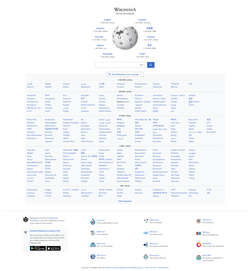Website
A website is a set of webpages that are joined. People look at websites with a computer of some kind, which can sometimes be the computer inside a mobile phone or a television. The websites are kept on computers called web servers.

Overview
changeThere is almost always a single homepage which has links to other pages that are part of that website. Sometimes it has links to pages that are part of other websites as well. (Note that net jargon uses the word "site", which also means a physical place in the real world, to mean a web URL). A home page serves as the introduction page of a website.
Some websites are used to advertise or sell things. Some websites can also be used to talk to other people. Many websites are good for looking up information on the computer. A blog is a website where the location of the material is less relevant than who writes it, and which is more focused on dialogue. Very often the people who use blogs dislike the word "site" since it implies a controlled place.
Accessing websites
changeUsers can access any website by using a URL. This is the website address which is shown near the top of the web browser. The homepage and the rest of the site usually have the same words at the start of the URL — for example, pages at the Simple English Wikipedia always start "http://simple.wikipedia.org/..." but are different after that. However, if a person does not buy a domain name, the website could be an IP Address. An example of an IP address is 172.217.13.228[permanent dead link].
Appearance
changeWeb sites are usually shown in HTML (Hyper Text Markup Language) but are not always written or kept that way - some use WAP and others use XML.
Website builder software is usually a collection of software tools that allow the construction of websites without manual code editing.[1] Several hosted website services have website builder software built-in.[1]
Types
changeThere are many different types of website based on their purpose and the type of organisation they are created for.[2]
- A blog (also known as weblog) is a website where the owner writes about subjects for others to read.[3]
- A wiki is a website where anyone can edit the pages.[4]
- Content Management Systems are software that can edit web pages through a WYSIWYG editor.
- A search engine is a website like Google, Bing and DuckDuckGo which can be used to search for information from different websites.[5]
- Social networking sites (Like Facebook, Twitter and Instagram) allow users to interact with people on the internet.[6]
- Quiz websites like Quotev, Buzzfeed, Allthetests and GoToQuiz are websites used to look at quizzes, fan-fictions and surveys about television, radio, music and other things done in society.
- Video websites like YouTube and TikTok exist to let users look at videos of people, places and things.
- Online forums, discussion, Q&A, and community websites let users discuss topics to learn about them or answer other users' questions.
- Membership websites allow users to access their services after purchasing their content or a subscription.
- Application websites, often simply known as Apps, are websites that ask users to download their app to access their services.
Domain types
changeWebsites have different kinds of domain endings, which are the two-or-three letter pieces after the period (".") on the website. Different website owners use different domain endings for different purposes.
- .com websites are the most common type of websites. They are often used for commercial services, like social media products and advertising. However, they can be used for any purpose.
- .org websites are websites that are owned by organisations.
- .net websites are websites that are often used for networking and other infrastructure services. However, the domain itself can be used for any purpose, much like .com.
- Many types of domains are specific to a country of the world. For example, .uk, .au and .us are mainly available in the United Kingdom, Australia and the United States, but some can be used outside of these countries.
- .io websites are websites using one of the cheaper domain ending types. Many of them are online game websites that connect to networks that are also used by other users.
- There are other types of websites that end in a period followed by certain letters, but there are too many to list.
References
change- ↑ 1.0 1.1 Peri Pakroo; Marcia Stewart, Small Business Start-Up Kit, The: A Step-by-Step Legal Guide (Berkeley, CA: Nolo, 2014), p. 251
- ↑ "13 Types of Websites SMEs Can Use to Grow Their Business". emerge360.co. 2022-01-08. Retrieved 2022-02-25.
- ↑ "Weblog". Computer Hope. Retrieved 3 April 2016.
- ↑ "7 things you should know about... Wikis" (PDF). EDUCAUSE. Archived from the original (PDF) on 9 March 2016. Retrieved 3 April 2016.
- ↑ "What is a search engine?". BBC. 6 June 2013. Archived from the original on 30 November 2016. Retrieved 3 April 2016.
- ↑ "social networking". The Free Dictionary. Farlex. Retrieved 3 April 2016.